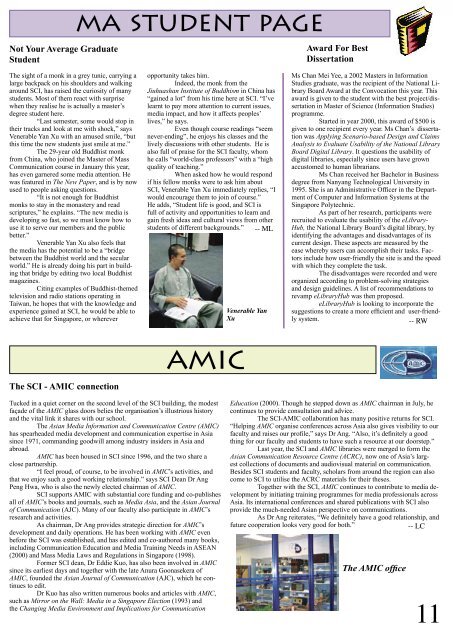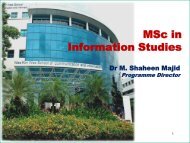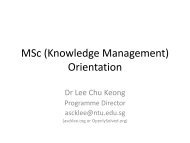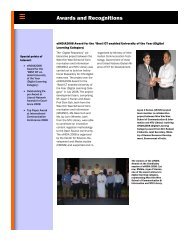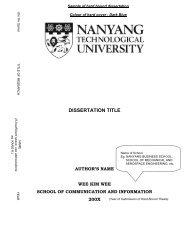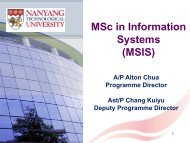Nov 2004 - Nanyang Technological University
Nov 2004 - Nanyang Technological University
Nov 2004 - Nanyang Technological University
You also want an ePaper? Increase the reach of your titles
YUMPU automatically turns print PDFs into web optimized ePapers that Google loves.
Not Your Average Graduate<br />
Student<br />
ma student page<br />
Award For Best<br />
Dissertation<br />
The sight of a monk in a grey tunic, carrying a<br />
large backpack on his shoulders and walking<br />
around SCI, has raised the curiosity of many<br />
students. Most of them react with surprise<br />
when they realise he is actually a master’s<br />
degree student here.<br />
“Last semester, some would stop in<br />
their tracks and look at me with shock,” says<br />
Venerable Yan Xu with an amused smile, “but<br />
this time the new students just smile at me.”<br />
The 29-year old Buddhist monk<br />
from China, who joined the Master of Mass<br />
Communication course in January this year,<br />
has even garnered some media attention. He<br />
was featured in The New Paper, and is by now<br />
used to people asking questions.<br />
“It is not enough for Buddhist<br />
monks to stay in the monastery and read<br />
scriptures,” he explains. “The new media is<br />
developing so fast, so we must know how to<br />
use it to serve our members and the public<br />
better.”<br />
Venerable Yan Xu also feels that<br />
the media has the potential to be a “bridge<br />
between the Buddhist world and the secular<br />
world.” He is already doing his part in building<br />
that bridge by editing two local Buddhist<br />
magazines.<br />
Citing examples of Buddhist-themed<br />
television and radio stations operating in<br />
Taiwan, he hopes that with the knowledge and<br />
experience gained at SCI, he would be able to<br />
achieve that for Singapore, or wherever<br />
opportunity takes him.<br />
Indeed, the monk from the<br />
Jiuhuashan Institute of Buddhism in China has<br />
“gained a lot” from his time here at SCI. “I’ve<br />
learnt to pay more attention to current issues,<br />
media impact, and how it affects peoples’<br />
lives,” he says.<br />
Even though course readings “seem<br />
never-ending”, he enjoys his classes and the<br />
lively discussions with other students. He is<br />
also full of praise for the SCI faculty, whom<br />
he calls “world-class professors” with a “high<br />
quality of teaching.”<br />
When asked how he would respond<br />
if his fellow monks were to ask him about<br />
SCI, Venerable Yan Xu immediately replies, “I<br />
would encourage them to join of course.”<br />
He adds, “Student life is good, and SCI is<br />
full of activity and opportunities to learn and<br />
gain fresh ideas and cultural views from other<br />
students of different backgrounds.” -- ML<br />
Venerable Yan<br />
Xu<br />
Ms Chan Mei Yee, a 2002 Masters in Information<br />
Studies graduate, was the recipient of the National Library<br />
Board Award at the Convocation this year. This<br />
award is given to the student with the best project/dissertation<br />
in Master of Science (Information Studies)<br />
programme.<br />
Started in year 2000, this award of $500 is<br />
given to one recipient every year. Ms Chan’s dissertation<br />
was Applying Scenario-based Design and Claims<br />
Analysis to Evaluate Usability of the National Library<br />
Board Digital Library. It questions the usability of<br />
digital libraries, especially since users have grown<br />
accustomed to human librarians.<br />
Ms Chan received her Bachelor in Business<br />
degree from <strong>Nanyang</strong> <strong>Technological</strong> <strong>University</strong> in<br />
1995. She is an Administrative Officer in the Department<br />
of Computer and Information Systems at the<br />
Singapore Polytechnic.<br />
As part of her research, participants were<br />
recruited to evaluate the usability of the eLibrary-<br />
Hub, the National Library Board’s digital library, by<br />
identifying the advantages and disadvantages of its<br />
current design. These aspects are measured by the<br />
ease whereby users can accomplish their tasks. Factors<br />
include how user-friendly the site is and the speed<br />
with which they complete the task.<br />
The disadvantages were recorded and were<br />
organized according to problem-solving strategies<br />
and design guidelines. A list of recommendations to<br />
revamp eLibraryHub was then proposed.<br />
eLibraryHub is looking to incorporate the<br />
suggestions to create a more efficient and user-friendly<br />
system.<br />
-- RW<br />
amic<br />
The SCI - AMIC connection<br />
Tucked in a quiet corner on the second level of the SCI building, the modest<br />
façade of the AMIC glass doors belies the organisation’s illustrious history<br />
and the vital link it shares with our school.<br />
The Asian Media Information and Communication Centre (AMIC)<br />
has spearheaded media development and communication expertise in Asia<br />
since 1971, commanding goodwill among industry insiders in Asia and<br />
abroad.<br />
AMIC has been housed in SCI since 1996, and the two share a<br />
close partnership.<br />
“I feel proud, of course, to be involved in AMIC’s activities, and<br />
that we enjoy such a good working relationship.” says SCI Dean Dr Ang<br />
Peng Hwa, who is also the newly elected chairman of AMIC.<br />
SCI supports AMIC with substantial core funding and co-publishes<br />
all of AMIC’s books and journals, such as Media Asia, and the Asian Journal<br />
of Communication (AJC). Many of our faculty also participate in AMIC’s<br />
research and activities.<br />
As chairman, Dr Ang provides strategic direction for AMIC’s<br />
development and daily operations. He has been working with AMIC even<br />
before the SCI was established, and has edited and co-authored many books,<br />
including Communication Education and Media Training Needs in ASEAN<br />
(2000) and Mass Media Laws and Regulations in Singapore (1998).<br />
Former SCI dean, Dr Eddie Kuo, has also been involved in AMIC<br />
since its earliest days and together with the late Anura Goonasekera of<br />
AMIC, founded the Asian Journal of Communication (AJC), which he continues<br />
to edit.<br />
Dr Kuo has also written numerous books and articles with AMIC,<br />
such as Mirror on the Wall: Media in a Singapore Election (1993) and<br />
the Changing Media Environment and Implications for Communication<br />
Education (2000). Though he stepped down as AMIC chairman in July, he<br />
continues to provide consultation and advice.<br />
The SCI-AMIC collaboration has many positive returns for SCI.<br />
“Helping AMIC organise conferences across Asia also gives visibility to our<br />
faculty and raises our profile,” says Dr Ang. “Also, it’s definitely a good<br />
thing for our faculty and students to have such a resource at our doorstep.”<br />
Last year, the SCI and AMIC libraries were merged to form the<br />
Asian Communication Resource Centre (ACRC), now one of Asia’s largest<br />
collections of documents and audiovisual material on communication.<br />
Besides SCI students and faculty, scholars from around the region can also<br />
come to SCI to utilise the ACRC materials for their theses.<br />
Together with the SCI, AMIC continues to contribute to media development<br />
by initiating training programmes for media professionals across<br />
Asia. Its international conferences and shared publications with SCI also<br />
provide the much-needed Asian perspective on communications.<br />
As Dr Ang reiterates, “We definitely have a good relationship, and<br />
future cooperation looks very good for both.”<br />
-- LC<br />
The AMIC office<br />
11


